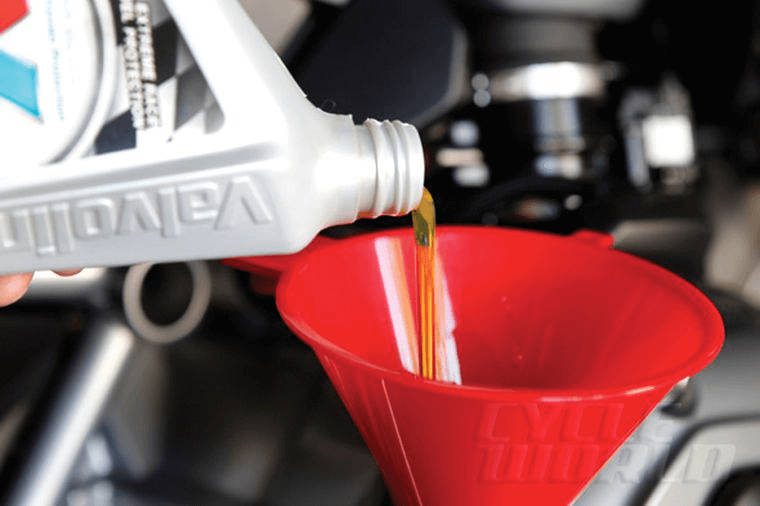
Engine oil is responsible for the lubrication of various components in your vehicle’s engine system, protecting them from early wear and tear caused by friction and overheating. In this article, we find out if slightly overfilling oil will damage the transmission.

Overfilling your transmission, even slightly causes your gears to splash as they rotate in the overfilled fluid. This splashing causes your oil to aerate, reducing its lubrication properties . Reduced lubrication causes increased friction, which results in a rise in temperature and pressure. The excess hydraulic pressure then causes different parts in and around your transmission and engine to snap and break, resulting in sudden or long term damage to your automatic transmission (AT).
For manual transmissions, overfilling the oil causes fluid to leak from the vent resulting in erratic gear shifting when the clutch is depressed. It cannot cause permanent damage to your manual transmission but instead affect the gearbox causing jerking and erratic shifting
What are some symptoms of too much transmission fluid?
- Erratic shifting
Gears require a certain level of pressure to function properly. Automatic transmissions rely on the hydraulic pressure created by the transmission fluid to change gears. Overfilling your transmission will cause the fluid to foam and implode when compressed between gears or in the hydraulics of your automatic transmission causing poor shifting of gears. With a manual transmission, the implosion affects the clutch causing you to experience clutch slippage and difficulty when depressing the clutch.
- Leakage
The presence of a pinkish-reddish oil spill under your parked vehicle is a sure indication that your transmission fluid is leaking. Overfilling your transmission fluid causes the fluid to flow into spaces with fixed volumes leading to a buildup in pressure forcing your gaskets and seals to crack and start leaking.
To counter this, manufacturers have begun designing transmissions with pressure valves and drains that allow only excess fluid to flow out. The cost of repair will depend on your vehicles make, and model and will usually range from $150-$250.
- Foamy transmission fluid
Foamy transmission fluid comes about when the gears splash in the overfilled fluid when rotating. The fluid should generally only be in the pan and not come into contact with the rotating gears. Once in contact with the spinning shafts, the fluid is exposed to air, which in turn compromises the chemical composition of the oil, causing it to foam. In an automatic transmission, the foam causes pressure to buildup damaging your vehicle’s transmission.
- Overheating
Once your transmission fluid begins to foam, it loses its viscosity, and this affects the way the fluid flows through the shifting gears. The fluid can no longer lubricate the gears as they rotate, causing the transmission to overheat. The heat affects the stability of transmission components, causing engine failure.
- Smoking
Oil expands when hot if you have overfilled your transmission to the point that the fluid is level with the opening of the oil filler tube it will spill out. The hot oil will spill onto the metal floor of your engine, and this will cause smoke to drift from underneath your bonnet. In worse cases, the hot oil comes into contact with the hot exhaust and combusts, causing a fire to erupt.
How much transmission fluid is too much?
Your transmission fluid should always be at the top end of the cold mark when the engine is cool and at the high end of the hot mark where the engine is hot. Transmission fluid in a warm engine should be at the safe zone between the two marks. It is advisable to add a half a quart of fluid at a time to avoid putting too much.
Most automatic transmission (unless sealed) comes with a dip-stick which measures the level of transmission fluid. Sometimes the dip-stick will show that the transmission is full when in actual fact it isn’t. For an accurate reading, you should start your engine, let it run for a few minutes before rechecking your fluid levels after it has sat idle and cooled. In the case of sealed transmissions, checking the level of transmission fluid becomes technical. You will need to locate the bolt that holds in your transmission fluid which is usually located at the bottom of your vehicle, remove it and proceed to check your fluid.
Manual transmissions on the hand don’t normally have a dip-stick, and one has to use the cap located on the side of the transmission to check fluid levels. The level of fluid should be at the same level as the bottom edge of the plug and not above or below it.
How to fix and avoid overfilling your transmission
You have overfilled your transmission if the fluid has passed full mark on the dip-stick by more than a quarter-inch when parked on level ground. You can quickly fix this by removing the excess fluid and opening the drain clog on the transmission drain pan, using a hand pump or siphoning it out through your transmission oil filler tube. Though most transmissions need 9 to 13 quarts to fill, always follow the manufacturer’s guide on the amount needed for your vehicle.
Also, go through your owner’s manual to find out the exact type of transmission fluid your vehicle needs. Some vehicles can’t use any off the shelf transmission fluid since this will end up damaging the engine. For example, continuously variable transmission and dual-clutch transmission take their own fluid.
Fixing an overfilled transmission in a manual vehicle is easier since they have an overflow plug on the outer case. You simply have to remove the plug while the vehicle is parked on a level surface and watch the excess fluid flow out.
Common problems due to low transmission fluid
The transmission fluid is what keeps the components of your transmission system running seamlessly and that is why if it is not used then the component parts are prone to tear and wear. Experiencing low transmission fluid is especially worse if you are driving an automatic car. Therefore, if you detect any of the below symptoms then you know that you are running low on transmission fluids.
- Surging transmission
If your vehicle lurches forward before falling backwards when driving then you should know that you have inadequate force from the fluid.
- Overheated transmission
Lack of adequate fluid to lubricate the components will cause a lot of friction thus lead to the excessive production of heat. To which end you will experience an overheated transmission if the shifts are delayed, you will also experience power loss, burning smells and gear slippage.
- Delay in gear engagement
With low fluid levels, you are bound to experience low pressure during transmissions, which will consequently cause delays when changing the gears. So during driving, you will notice that there is a delayed response any time that you try to move the gear stick to the reverse or drive mode.
- Gear slippage
Failure of the gear to stay at one mode after shifting it can be caused by either low fluid levels or due to the residue build-up that prevents the fluid to flow smoothly.
- Erratic shifts
An erratic shift is when the shifting of the gears happens too soon or too late, caused by low transmission fluid especially in automatic cars. And to prove that the low fluid problem is indeed the cause you will hear a banging sound.
If your car is having transmission problems, then it should not be on the road, but in case you are already on the road, and start experiencing the above problems then just pull it to the side, let the components cool off and when the temperature has gone back to normal get a tow truck and have it taken to the relevant repair shop.
Important to note is that high temperatures on your transmission will cause damage.
Frequently Asked Questions
- What type of transmission fluid does my car need?
Transmission fluids act as coolants, however, their primary function is to lubricate the various parts of the transmission. It can also protect and clean the metal surfaces from wear.
Different types of cars (make and model) will utilize different types of transmission fluid for example, if you are driving the GM Toyota then you will have to use the Dexron VI, for those driving a Nissan, Subaru or an Infiniti they will use Matic S, K, and D. And for the Hyundai, Mitsubishi and Kia drivers then the Hyundai automatic transmission fluid SP-III will suffice.
- Is it safe to put oil in a transmission fluid?
Using motor oil instead of the transmission fluid is detrimental to the health of your transmission. The first terrible thing that will happen is that your transmission will fail, because of slipping and wearing out of the clutches and bands.
- How often do I need to change the transmission oil?
Manual transmission oil should be changed every 30 to 60,000 miles. However, if your car is put under heavy-duty use you might have to change your transmission fluid after every 15,000miles.
- Should I change or flush my transmission fluid?
Transmission flush will get rid of all the fluid in the pan while a transmission fluid change, is meant to drain the dirty fluid from the pan.
In conclusion
One of the more common causes of transmission damage is poor transmission fluid maintenance. You should always maintain the right fluid level and know when you need to change your fluid. The level of fluid is vital to the running of your engine. The amount of fluid you add therefore depends on whether you plan on draining, replacing or merely topping it off.
